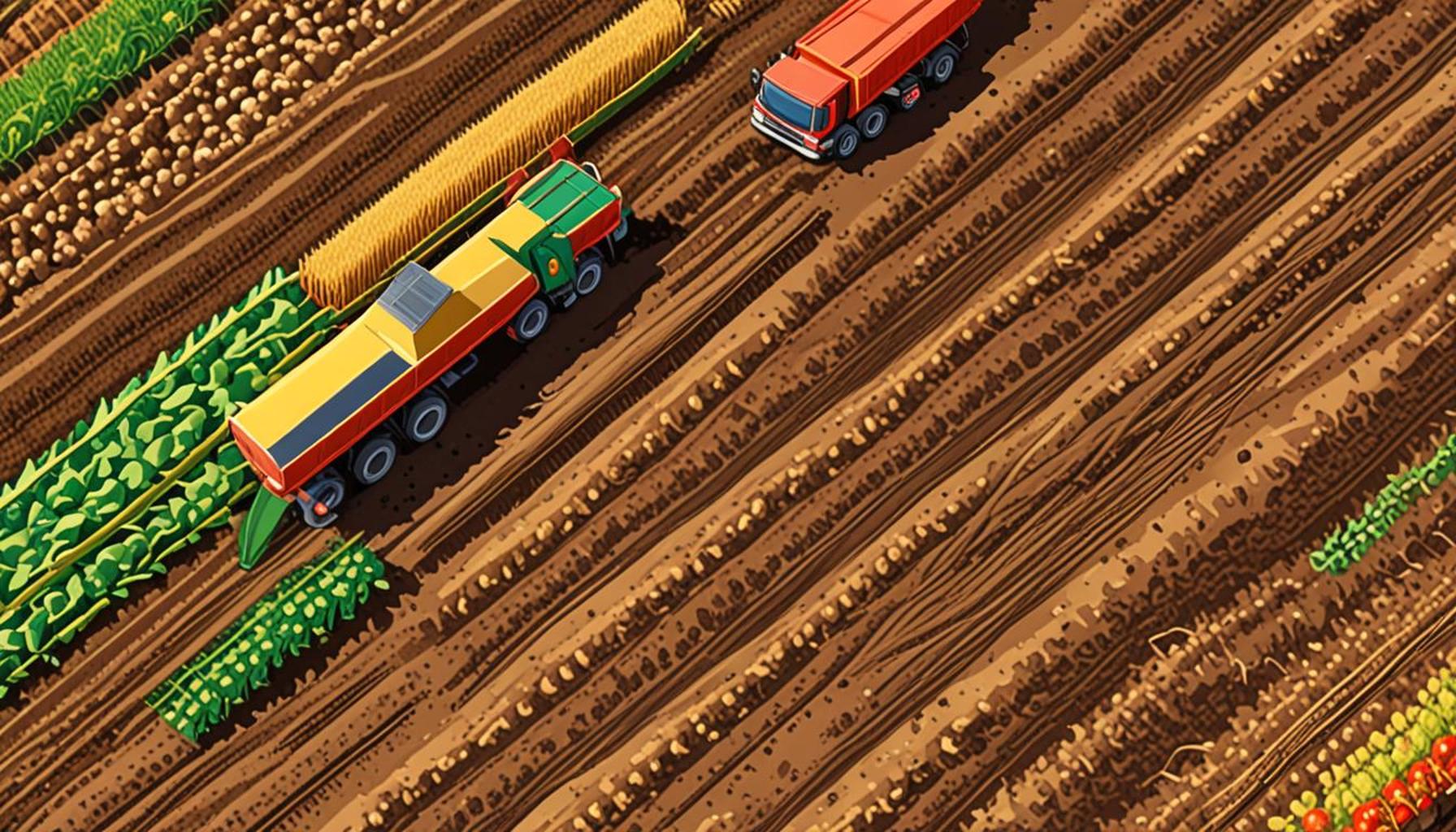Harvest and Biodiversity: How Crop Rotation Can Improve Harvest Timing and Soil Health

The Relationship Between Farming and Ecosystems
The relationship between farming practices and natural ecosystems is more profound than one may realize. One effective agricultural approach gaining traction is crop rotation. This method involves alternating the types of crops grown on a particular piece of land over time, enhancing both harvest timing and soil health. The benefits of crop rotation extend far beyond mere convenience; they represent a crucial strategy for increasing agricultural sustainability and resilience.
Understanding the Benefits of Crop Rotation
Why is crop rotation pivotal for farmers? Here are some compelling reasons:
- Improved Soil Nutrients: Different crops contribute varying nutrients to the soil. For example, legumes such as beans and peas fix nitrogen in the soil, enriching it for subsequent crops like corn, which require high nitrogen levels. This natural fertilizer effect reduces the need for synthetic fertilizers, ultimately saving farmers money and minimizing environmental impact.
- Disease Prevention: Rotating crops helps disrupt pest and disease cycles. For instance, if a field is planted with potatoes for several seasons, it can become infested with specific pests like the Colorado potato beetle. By rotating to a different crop, farmers can significantly reduce pest populations and lower the need for chemical pesticides.
- Enhanced Biodiversity: A diverse crop system promotes richer ecosystems. In the United States, farmers who mix crops create habitats for beneficial insects, like pollinators, which can lead to increased yields. For example, a mixed planting of flowers alongside vegetables can attract bees, enhancing pollination rates and promoting healthier crops.
In the United States, where agricultural practices directly influence food supply and economy, understanding these benefits can guide farmers toward sustainable practices. For instance, rotating corn and soybeans not only improves yields but also minimizes inputs like fertilizers and pesticides. This practice is common in the Midwest, where many farmers have reported increased profitability and soil health due to such rotations.
The Challenges of Climate Change
As climate change continues to alter agricultural landscapes, adopting practices like crop rotation may be essential for maintaining productivity and sustainability. Weather patterns may become unpredictable, which could affect crop yields. By employing crop rotation, farmers can better adapt their practices to local conditions and reduce their vulnerability to climate variability.
Moreover, crop rotation offers a holistic approach to farming that considers both harvest outcomes and environmental health. Institutions and agricultural extension services in the U.S. are increasingly promoting this sustainable practice, encouraging farmers to explore new pathways for growing food responsibly. By reevaluating traditional farming methods in light of these findings, there is great potential for enhancing agricultural resilience and ensuring food security for future generations.

DISCOVER MORE: Click here to learn about climate effects on harvest timing
The Advantages of Implementing Crop Rotation
The merits of crop rotation are numerous and deeply intertwined with the principles of sustainable agriculture. By embracing this time-honored practice, farmers can unlock a multitude of benefits that not only enhance their economic viability but also fortify the ecological integrity of their farming systems. When farmers intentionally alternate the crops planted in their fields, they contribute to a cycle that balances the needs of crops with the well-being of the soil and surrounding ecosystems.
Boosting Soil Structure and Health
One of the most significant advantages of crop rotation is its positive impact on soil health. Different crops contribute uniquely to the soil ecosystem, enhancing both its structure and nutrient profile. For instance, root systems of diverse plants can help to break up compacted soil, improving water infiltration and aeration. Some key benefits include:
- Carbon Sequestration: Diverse root structures capture more carbon dioxide, thus mitigating climate impact and fostering healthier atmospheric conditions.
- Water Retention: Crops such as cover crops can enhance soil moisture retention, reducing the need for irrigation and promoting more efficient water use.
- Microbial Diversity: The variety of crops enriches the soil microflora, fostering a robust community of beneficial bacteria and fungi that play crucial roles in nutrient cycling and disease suppression.
The capacity of crop rotation to improve harvest timing is another compelling reason to consider its implementation. Strategic planning of planting schedules and crop sequences can result in optimal harvesting windows, aligning with market demands and climatic conditions. For instance, farmers who rotate fast-growing cover crops, such as radishes or clover, with slower-growing staples like corn, can spread out harvest activities, reducing the labor burden during peak seasons.
Enhancing Pest Control Naturally
Crop rotation serves as a powerful tool for integrated pest management as well. By alternating crops, farmers disrupt the life cycles of pests that thrive on a single crop. For example, if a farmer grows brassicas—such as broccoli or cabbage—in one season and then rotates to a leguminous crop like beans the next, pests specific to brassicas are less likely to find a food source and reproduce. This natural interruption can drastically reduce pest populations, leading to lower reliance on chemical pesticides. Some significant highlights include:
- Improved Crop Resilience: Healthier agroecosystems are better equipped to fend off pest and disease outbreaks.
- Cost Savings: Reduced pesticide use directly correlates to lower input costs and increased profitability.
- Environmental Protection: Less reliance on chemicals not only supports biodiversity but also safeguards surrounding ecosystems from harmful runoff.
Fostering effective crop rotation is not merely an environmental consideration; it is a necessity for farmers looking to secure their livelihoods amidst changing climatic and economic landscapes. As we continue to delve into the interconnectedness of harvest and biodiversity, it becomes increasingly clear that the practices we adopt today will define the efficacy and sustainability of agriculture for generations to come.
Enhancing Soil Health Through Biodiversity
Crop rotation significantly enhances soil health by improving its structure, fertility, and biological diversity. Different crops contribute various nutrients and organic matter to the soil, which can lead to a more balanced ecosystem. For instance, legumes, such as peas and soybeans, fix nitrogen in the soil, enriching nutrient content for subsequent crops. This natural process reduces the dependency on chemical fertilizers, leading to a more sustainable farming practice.
The Role of Diverse Planting
Diversifying crop selections during rotation not only mitigates pest outbreaks but also strengthens the overall resilience of the soil. Each crop has distinct root structures and growth patterns, which aerate the soil differently and support various soil organisms. This increased biodiversity helps to build a robust soil microbiome, crucial for nutrient cycling and enhancing plant health.
Moreover, healthy soil is fundamental to effective water retention, which is increasingly crucial amid changing climate conditions. Crops with deeper root systems can tap into moisture reserves that surface roots cannot access, helping to maintain productivity during drier periods. As a result, farmers can optimize harvest timing and reduce losses due to adverse weather, ensuring a more reliable yield year after year.
Increasing Crop Yields
Regularly rotating crops can lead to increased crop yields. Rotations disrupt pest and disease cycles, leading to reduced damage and loss. A comprehensive study found that farmers practicing crop rotation achieved yields up to 30% higher compared to monoculture practices. This translates into more reliable harvests and better returns for growers.Ultimately, understanding the intricate connections between crop rotation, biodiversity, and soil health not only preserves agricultural systems but also strengthens food security, promoting a sustainable future for both farmers and consumers. As farmers explore these practices, they unlock opportunities to enhance their management strategies while contributing to a healthier planet.
| Category | Benefits |
|---|---|
| Soil Nutrient Management | Maintaining soil health through diverse nutrient contributions from various crops. |
| Pest and Disease Control | Disrupting life cycles of pests and diseases, reducing crop damage and losses. |
DISCOVER MORE: Click here for essential tips on creating a pest-resistant garden
Building Resilience Against Climate Change
As the impacts of climate change become increasingly apparent, the agricultural sector faces heightened challenges such as unpredictable weather patterns, but crop rotation can play a pivotal role in enhancing resilience. By diversifying crops, farmers can mitigate risks associated with climate variability, reducing the vulnerability of their operations to extreme conditions. Different plants react uniquely to stressors such as drought or excessive rainfall, and rotating crops can provide a buffer against these fluctuations. For instance, incorporating deep-rooted crops can help to draw moisture from deeper soil layers, which is invaluable during periods of insufficient rainfall.
Improving Nutrient Utilization
Another underappreciated benefit of crop rotation is its ability to enhance nutrient utilization within the soil. Each crop has distinct nutrient requirements, and rotating them can prevent the depletion of specific nutrients. Legumes, for example, possess the ability to fix atmospheric nitrogen into the soil, enriching it for subsequent crops. Following a season of legumes with nitrogen-demanding crops such as corn can promote healthier yields and reduce the need for synthetic fertilizers. This practice not only optimizes plant health and productivity but also minimizes the risk of nutrient runoff into waterways, contributing to overall environmental health.
- Enhanced Soil Fertility: By incorporating various crops that utilize and replenish different nutrients, soil fertility can be maintained or even increased over time.
- Reduction in Fertilizer Costs: Utilizing naturally nitrogen-fixing crops can lessen the dependency on chemical fertilizers, resulting in significant cost savings for farmers.
- Strategic Crop Pairings: Utilizing intercropping—growing two or more crops simultaneously—can further improve nutrient use efficiency and overall yields.
Furthermore, strategic crop rotation can optimize harvest timing by ensuring that fields yield produce at staggered intervals. This planning allows farmers to access a wider range of markets, accommodating consumer demand throughout the growing season. For instance, after harvesting an early summer crop like lettuce, farmers can quickly plant a fast-maturing crop such as radishes or beets, ensuring a continual supply of fresh produce. This not only stabilizes income streams but also mitigates the shock of market fluctuations.
Encouraging Biodiversity Beyond the Farm
The practice of crop rotation also extends its positive effects beyond the confines of the farm. Encouraging biodiversity fosters stable ecosystems not only above ground but within the soil itself. Increased plant diversity leads to a higher organism count in both flora and fauna, enriching habitats for pollinators and beneficial insects. These relationships are crucial, as many of these organisms play a significant part in pollination and natural pest control, dovetailing with the goals of sustainable agriculture.
- Support for Local Pollinators: Diverse plantings help attract beneficial insects, enhancing pollination rates and improving crop yields.
- Soil Health Benefits: As soil organisms thrive, they contribute to healthier soil ecosystems which can resist erosion, compaction, and degradation.
- Agroecological Synergies: By fostering a balance of plant and animal life, farms can create more resilient systems that mimic natural ecosystems.
Incorporating crop rotation into agricultural practices is not merely an operational decision; it is a strategic move that can support both the economic viability of farms and the sustainability of our shared environment. As farmers seek innovative solutions and resilient practices, crop rotation emerges as a cornerstone of both productivity and ecological health.
DISCOVER MORE: Click here
Conclusion
In summary, the practice of crop rotation is not merely an agronomic strategy but a transformative approach that enhances both harvest timing and soil health. By fostering biodiversity, farmers can create resilient systems capable of withstanding the unpredictability of climate change while simultaneously optimizing nutrient utilization. The diverse plant combinations that arise from crop rotation increase soil fertility naturally, decrease reliance on chemical fertilizers, and contribute to significant cost savings for producers.
Moreover, adopting integrated cropping practices allows farmers to align their production schedules with market demands, ensuring a steady stream of fresh produce throughout the growing season. This adaptability is crucial for maintaining economic stability amidst fluctuating market conditions. The multiple benefits of crop rotation extend beyond individual farms, promoting ecological health by attracting beneficial insects and supporting local pollinator populations that are essential for sustainable agricultural practices.
As the agricultural landscape continues to evolve, embracing crop rotation signifies a commitment to sustainable farming that harmonizes productivity with ecological integrity. It is imperative for both farmers and consumers to recognize crop rotation as an essential component of the future of agriculture, ensuring not only food security but also the preservation of our planet’s biodiversity. The potential of this age-old practice invites further exploration and innovation, urging us to rethink our commitment to methods that nourish our soil and the communities that rely on it.



